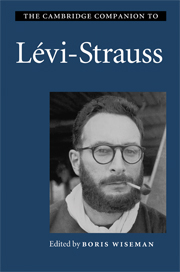Book contents
- Frontmatter
- Introduction
- Part I: Society and culture
- Part II: Myth and mind
- Part III: Language and alterity
- Part IV: Literature and aesthetics
- 13 Structuralism, poetry, music: Lévi-Strauss between Mallarmé and Wagner
- 14 Morphology and structural aesthetics: from Goethe to Lévi-Strauss
- 15 Structure and sensation
- Bibliography of works by Claude Lévi-Strauss
- Index
15 - Structure and sensation
from Part IV: - Literature and aesthetics
Published online by Cambridge University Press: 28 January 2010
- Frontmatter
- Introduction
- Part I: Society and culture
- Part II: Myth and mind
- Part III: Language and alterity
- Part IV: Literature and aesthetics
- 13 Structuralism, poetry, music: Lévi-Strauss between Mallarmé and Wagner
- 14 Morphology and structural aesthetics: from Goethe to Lévi-Strauss
- 15 Structure and sensation
- Bibliography of works by Claude Lévi-Strauss
- Index
Summary
In the 1670s, a famous quarrel occurred at the Académie royale de peinture et de sculpture about whether line or colour is more important in painting. It opposed the Poussinistes, lead by Le Brun, the then director of the Académie and Premier Peintre du Roi, to the Rubenistes. The former defended a rationally inspired pictorial classicism; the latter, the expressive force of colour. One of the key arguments put forward by the former camp, which was ultimately victorious, was that line was superior to colour because it appealed to the intellect, whereas colour only appealed to the senses. Viewed as a purely aesthetic debate, it appears today largely spurious. Its significance lies elsewhere, in what it tells us about seventeenth-century mentalities, and the conceptions that shaped them. It also provides a good analogy for certain aspects of the debate that accompanied the dissemination of structuralist ideas, a kind of modern philosophical version of the quarrel between Poussinistes and Rubenistes.
Lévi-Strauss's detractors have often reproached him for his intellectualism and accused him, as it were, of favouring line - i.e. 'pure' structures - over colour - i.e. the materials or substances from which these structures have been 'extracted'. The first few pages of Derrida's 'Force and Signification', the opening essay of Writing and Difference, articulate just such a vision of structuralism. The structuralist method, Derrida argues, attains its goal at the cost of splitting the creative force of a work of literature from the structures in which force inheres. In the process, it relinquishes any attempt to understand force from the inside. Its inspiration, he continues, is essentially 'panorographic'.
- Type
- Chapter
- Information
- The Cambridge Companion to Lévi-Strauss , pp. 296 - 314Publisher: Cambridge University PressPrint publication year: 2009



